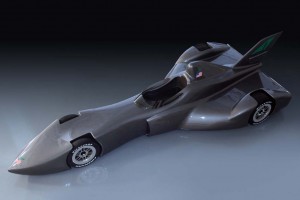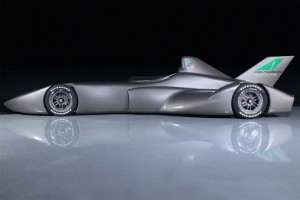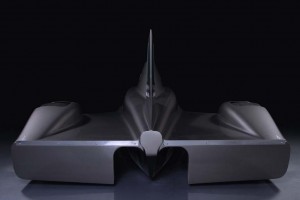
Looking more like a comic book impression of a race car, the DeltaWing Concept could transform motor sports, say sponsors.
It’s got a sort of “Back to the Future” look that would seem comfortable on the pages of a comic book,” but could the DeltaWing race car concept revolutionize real world motor sports? That’s the question surrounding the steel gray prototype on display at this year’s Chicago Auto Show, an event more commonly known for introducing new sedans and sport-utility vehicles.
Developed by DeltaWing LLC, which is appropriately based in Indianapolis, the 2012 DeltaWing IndyCar Concept is being billed as “the future of open-wheel racing.” Among other things, the design promises to be more fuel-efficient than conventional race cars, as well as safer. Using less power and about half the fuel of a traditional IndyCar, the developers claim they have turned consistent 235 mph laps.
“This radical prototype takes open wheel racing to a new level from both an engineering standpoint and the overall spectator experience,” proclaimed DeltaWing CEO Dan Partel, during the debut of the race car concept, which will be on exhibit during the Chicago Auto Show’s public days at the Bridgestone/Firestone stand – the tire maker partnering in the development project. Among other things, it came up with special Firestone Firehawk tires for the prototype.)
The design of the cars that have run the “Brickyard,” and later, the IndyCar series, have steadily evolved over the decades. But even by those standards, the DeltaWing’s styling really is a radical departure.
The dart-like shape resembles a delta-winged fighter jet, stretching like an arrow from the extended nose back to the triangular wings that give the prototype both its name and instantly recognizable appearance. Twin inlets, mounted on either side of the cockpit, and an unusual tail, or vertical stabilizer, complete the jet-like shape. Significantly, the wheels on the 2012 DeltaWing Concept are partially enclosed to enhance aerodynamics.
Reducing drag can help boost performance, designers explain, even as it improves fuel economy and permits the use of a smaller, lighter engine.
“We are confident that this car will outperform the current generation IndyCar and do it in a more environmentally friendly way,” said Partel. Preliminary results indicate a stunning 100% improvement in fuel efficiency over a conventional IndyCar.
Development work began in 2009, at Target Chip Ganassi Racing, based in Minneapolis. The first running prototype will feature a turbocharged 2.0-liter inline-four engine. Computer modeling suggests it will need to be tuned to deliver at least 300 horsepower to achieve its performance targets. The engine is planned to run for 4,000 miles before needing a rebuild.
A 6-speed transmission will be used on oval tracks, a 5-speed gearbox with reverse will be the option for road courses. Gearing will be operated by sequential paddle shift activation.
With a 125-inch wheelbase, the DeltaWing Concept distributes far more of its 1,030 pounds towards the large rear end than with a normal IndyCar design. The wings help enhance downforce, according to developers, and improve the traction of the rear wheels. An unusual 60% of the concept’s braking force will be developed behind the center of gravity.
While most of the numbers are still simulations, a running prototype is planned for August 2010.


